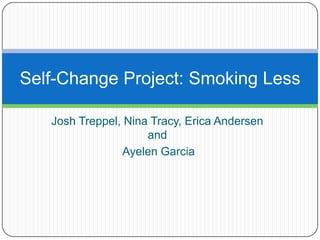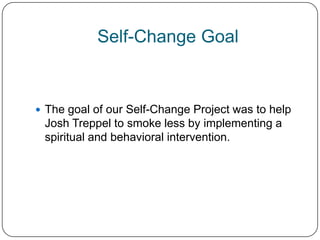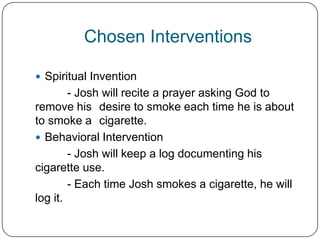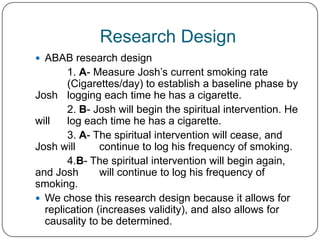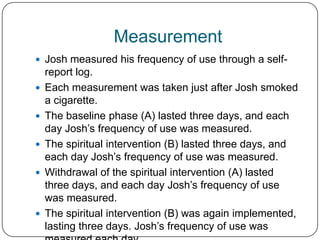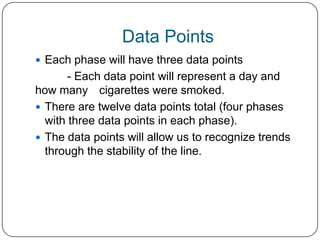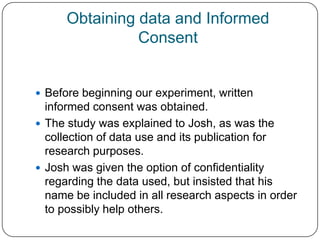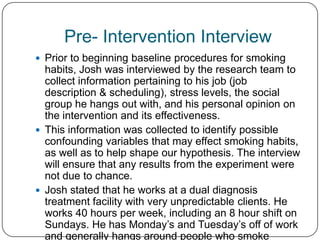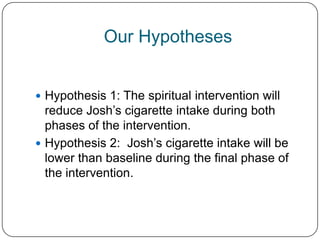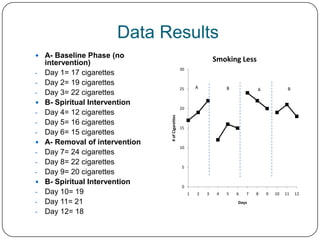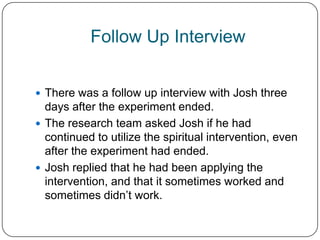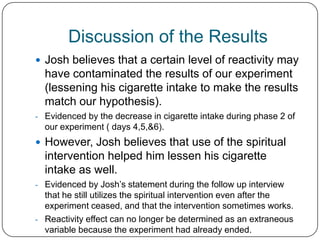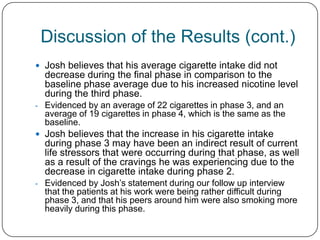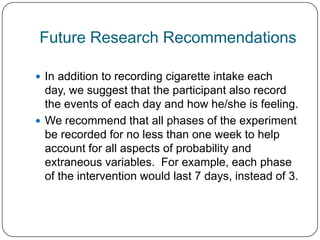Evidence based practice self-change project
- 1. Self-Change Project: Smoking Less Josh Treppel, Nina Tracy, Erica Andersen and Ayelen Garcia
- 2. Self-Change Goal ď‚— The goal of our Self-Change Project was to help Josh Treppel to smoke less by implementing a spiritual and behavioral intervention.
- 3. Chosen Interventions ď‚— Spiritual Invention - Josh will recite a prayer asking God to remove his desire to smoke each time he is about to smoke a cigarette. ď‚— Behavioral Intervention - Josh will keep a log documenting his cigarette use. - Each time Josh smokes a cigarette, he will log it.
- 4. Research Design  ABAB research design 1. A- Measure Josh’s current smoking rate (Cigarettes/day) to establish a baseline phase by Josh logging each time he has a cigarette. 2. B- Josh will begin the spiritual intervention. He will log each time he has a cigarette. 3. A- The spiritual intervention will cease, and Josh will continue to log his frequency of smoking. 4.B- The spiritual intervention will begin again, and Josh will continue to log his frequency of smoking.  We chose this research design because it allows for replication (increases validity), and also allows for causality to be determined.
- 5. Measurement  Josh measured his frequency of use through a self- report log.  Each measurement was taken just after Josh smoked a cigarette.  The baseline phase (A) lasted three days, and each day Josh’s frequency of use was measured.  The spiritual intervention (B) lasted three days, and each day Josh’s frequency of use was measured.  Withdrawal of the spiritual intervention (A) lasted three days, and each day Josh’s frequency of use was measured.  The spiritual intervention (B) was again implemented, lasting three days. Josh’s frequency of use was
- 6. Data Points ď‚— Each phase will have three data points - Each data point will represent a day and how many cigarettes were smoked. ď‚— There are twelve data points total (four phases with three data points in each phase). ď‚— The data points will allow us to recognize trends through the stability of the line.
- 7. Obtaining data and Informed Consent ď‚— Before beginning our experiment, written informed consent was obtained. ď‚— The study was explained to Josh, as was the collection of data use and its publication for research purposes. ď‚— Josh was given the option of confidentiality regarding the data used, but insisted that his name be included in all research aspects in order to possibly help others.
- 8. Pre- Intervention Interview  Prior to beginning baseline procedures for smoking habits, Josh was interviewed by the research team to collect information pertaining to his job (job description & scheduling), stress levels, the social group he hangs out with, and his personal opinion on the intervention and its effectiveness.  This information was collected to identify possible confounding variables that may effect smoking habits, as well as to help shape our hypothesis. The interview will ensure that any results from the experiment were not due to chance.  Josh stated that he works at a dual diagnosis treatment facility with very unpredictable clients. He works 40 hours per week, including an 8 hour shift on Sundays. He has Monday’s and Tuesday’s off of work and generally hangs around people who smoke
- 9. Our Hypotheses  Hypothesis 1: The spiritual intervention will reduce Josh’s cigarette intake during both phases of the intervention.  Hypothesis 2: Josh’s cigarette intake will be lower than baseline during the final phase of the intervention.
- 10. Data Results ď‚— A- Baseline Phase (no intervention) Smoking Less 30 - Day 1= 17 cigarettes - Day 2= 19 cigarettes 25 A B A B - Day 3= 22 cigarettes ď‚— B- Spiritual Intervention 20 - Day 4= 12 cigarettes # of Cigarettes - Day 5= 16 cigarettes 15 - Day 6= 15 cigarettes ď‚— A- Removal of intervention 10 - Day 7= 24 cigarettes - Day 8= 22 cigarettes 5 - Day 9= 20 cigarettes ď‚— B- Spiritual Intervention 0 - Day 10= 19 1 2 3 4 5 6 7 8 9 10 11 12 - Day 11= 21 Days - Day 12= 18
- 11. Follow Up Interview  There was a follow up interview with Josh three days after the experiment ended.  The research team asked Josh if he had continued to utilize the spiritual intervention, even after the experiment had ended.  Josh replied that he had been applying the intervention, and that it sometimes worked and sometimes didn’t work.
- 12. Analyzing the Results  The results of our experiment show that the spiritual intervention did reduce cigarette intake during both of the spiritual intervention phases (hypothesis 1). - Evidenced by Josh’s cigarette intake decreasing by 5 cigarettes during the first spiritual intervention phase (Josh had an average of 19 cigarettes during days 1,2, &3 and an average of 14 cigarettes during days 4,5, & 6). - Evidenced by Josh’s cigarette intake decreasing by 3 cigarettes during the second spiritual intervention phase (Josh had an average of 22 cigarette during days 7, 8, & 9 and an average of 19 cigarettes during days 10,11, & 12).  The results of our experiment show that Josh’s cigarette intake returned to baseline during the final phase of our experiment, instead of being lower than baseline (hypothesis 2). - Evidenced by the average number of cigarettes both being 19 during days 1,2, & 3 and 10,11, & 12.
- 13. Discussion of the Results  Josh believes that a certain level of reactivity may have contaminated the results of our experiment (lessening his cigarette intake to make the results match our hypothesis). - Evidenced by the decrease in cigarette intake during phase 2 of our experiment ( days 4,5,&6).  However, Josh believes that use of the spiritual intervention helped him lessen his cigarette intake as well. - Evidenced by Josh’s statement during the follow up interview that he still utilizes the spiritual intervention even after the experiment ceased, and that the intervention sometimes works. - Reactivity effect can no longer be determined as an extraneous variable because the experiment had already ended.
- 14. Discussion of the Results (cont.)  Josh believes that his average cigarette intake did not decrease during the final phase in comparison to the baseline phase average due to his increased nicotine level during the third phase. - Evidenced by an average of 22 cigarettes in phase 3, and an average of 19 cigarettes in phase 4, which is the same as the baseline.  Josh believes that the increase in his cigarette intake during phase 3 may have been an indirect result of current life stressors that were occurring during that phase, as well as a result of the cravings he was experiencing due to the decrease in cigarette intake during phase 2. - Evidenced by Josh’s statement during our follow up interview that the patients at his work were being rather difficult during phase 3, and that his peers around him were also smoking more heavily during this phase.
- 15. Future Research Recommendations ď‚— In addition to recording cigarette intake each day, we suggest that the participant also record the events of each day and how he/she is feeling. ď‚— We recommend that all phases of the experiment be recorded for no less than one week to help account for all aspects of probability and extraneous variables. For example, each phase of the intervention would last 7 days, instead of 3.

